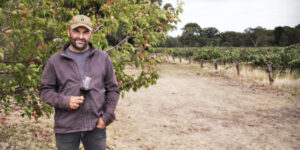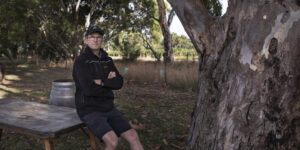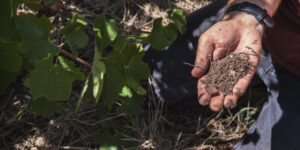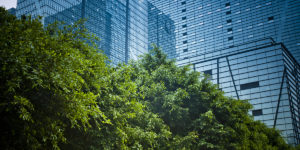Read our news: sustainability and decarbonation
- The lifecycle of a Hither & Yon wine: closed loop product
- Can nature be repaired with an invisible hand? Assessment of the Nature Repair Market Bill (NRM)
- Upcoming ESG webinars: Register your interest
Missing out on our news? Subscribe to our newsletter.
The lifecycle of a Hither & Yon wine
Closed loop product from off farm to the customer’s table.
The two most important things in our life? Soil and People. If both are healthy and happy, we have a promising future. – the Brothers Leask, Hither & Yon Wines, SA.

Malcolm and Richard Leask of Hither & Yon Wines are second generation farmers with vineyards in the Fleurieu Peninsula of South Australia. The brothers are climate trail blazers in the region: they practice regenerative farming and they have undertaken a lifecycle analysis of their wines as part of their Climate Active carbon neutral certification (FY 2019/2020). The LCA measured the total impact of Hither & Yon products – from the creation of the wine to the aluminium bottle cap, from energy usage to transport.
Why undergo the rigours of measurement and certification? For Hither & Yon Director and Creator, Malcolm Leask, the reasons for action are incontrovertible and in front of him every day. He explains that the changing climate has already made an impact on their region. Planning for both climate mitigation and climate adaptation are crucial for a secure future in winemaking. Adaptation for Hither & Yon involves experimentation with unusual varieties for the region. The brothers grow vines typically found in southern Italy, Spain, and Portugal where grapes grow in hotter temperatures, and importantly, with less water. This puts Hither & Yon in good stead for a hotter, dryer future.
A commitment to nature repair

The Leask brothers call themselves alternative futurists. Led by Richard, a regenerative farmer and Nuffield Scholar, they are part of a growing movement of growers across the globe who feel a moral responsibility to advocate for stewardship of the land through restoring soil health and reviving collapsing ecosystems. In addition to a commitment to the science available to them – the Lifecycle Assessments and Climate Active certification processes – they have left behind the techniques and interventions of traditional farming and allow nature to guide them.
From Hither & Yon’s perspective…
We talked to Malcolm Leask about Hither & Yon’s LCA and the brothers’ on-the-ground commitment to climate action.

PA:
In your words, in addition to the work on the ground, why did you decide to take on formalised systems of measurement such as the LCA and Climate Active processes?
ML:
From a personal perspective, I really wanted to translate what Richard and his team do on our land into a real live part of Hither & Yon brand. It allows us firstly to understand better the benefits of regenerative agriculture internally but also tell our story from grass to glass, and what we are trying to do better to lighten our footprint.
PA:
What did you learn from the LCA? Where were your biggest impacts and where did you need to make change? Did you have any surprises?
ML:
Vitally, that we are very lucky to have a full, closed loop product, from off farm to our customers’ tables, and we can influence this long term, but also daily. In our family business strategy, striving for net zero is a major action plan and we constantly challenge ourselves to think creatively and innovate for change. It is a great decision-making driver. The biggest impact was certainly our wine production and route to market, I was really surprised by logistics and travel emissions so we are trying to improve all of these areas in our strategy.
PA:
Your LCA lists wine making services as your most significant impact (about 50%). Can you break that down and describe what is contained within those services?
ML:
This starts from the time the grapes leave our vineyard and goes up to the winery. So, there is transport, processing and maturing, storage and finally bottling. We are pretty light from a winemaking perspective, allowing the fruit to express its place, so this helps. Both vineyards and winery are certified with Sustainable Winegrowing Australia, so we try and reduce our impact as much as we can with renewables and recyclables. Certainly, our wine packaging is a constant source of research, consumer and supplier, to see what we can improve as it’s a big contributor to our emissions. This part I think is our biggest challenge and opportunity.
PA:
Hither & Yon is among the first movers in climate action in the South Australian wine market. What are some of the commercial benefits from the LCA of your products and Climate Active certification? Do you have a favourite success story?
ML:
I’ve been really surprised and pleased by the interest and engagement of being carbon neutral, certainly being the first wine brand in SA certified by Climate Active. This is an important part of our business development in export markets, and I think we can strongly connect our certification with our new partners in the USA, Canada, and South Korea. Also, it’s so nice that Climate Active certification attracts a healthy customer base locally as well through our wine club, cellar door, and community partners. Along with being regenerative and sustainable, our story is on trend: environmental but at same time dynamic in nature.
From the Climate Active network, it’s pleasing that we have two alternative wines about to start pouring on Qantas business class, the wine must be exceptional, but the green message helps!
PA:

You and Richard adapt to climate change through the unusual varieties you grow in your region. Can you tell us about a few of the wines and how experimentation helps Hither & Yon brand growth through differentiation?
ML:
I think this was really the start of our regenerative agriculture and brand journey. As Richard says: ‘right plant in the right place’. He’s been planting new varieties since 2006 on our home Hither & Yon vineyard. Now we have 22 varieties with plans for more, just small lots to create batches of wine for our loyal and growing customers.
The Italian wines have great personality and are delicious sharing wines for our regional Mediterranean food. Aglianico, Nero d’Avola, Montepulciano are the reds, joined with new whites, Greco, Fiano and Vermentino. This, along with the Iberian varieties we grow, allow for constant refreshing conversation with our agents about what is on trend, and making sure we are top of mind for seasonal wine list changes. We have something for all tastes!
PA:
Recently the Federal Government introduced the Nature Repair Market Bill (NRM) which focuses squarely on biodiversity and reviving ecosystems. As well as practicing regenerative farming, you and Richard are committed to additional environmental initiatives in your own community. Can you tell us about some of your work?
ML:
This is really good to hear as biodiversity is as important to us as sustainability. Working with our local government partner, Landscape SA Hills & Fleurieu, we have a biodiversity management program for each of our family properties. We jointly call this ‘wildlife into wine’. This work includes production, watercourse, and planting zones, and also thinking about fauna, insects and soils. We are landscape partners of Biodiversity McLaren Vale which is a wildly popular and important community group doing great work. Our partnership with Trees for Life commits us to raising funds and helping TFL plant 2000 native seedlings on one of their South Australia projects each year.
PA:
A final question – what does regenerative farming mean to a glass of Hither & Yon wine – let’s say a 2021 Aglianico?*
ML:
A wine that has energy, tension, and connectivity to place – where it was grown. We quite often get comments about the mineral, earthy, and botanic, natural taste of our wines. This is certainly the case with our 2021 Aglianico. Different, delicious and ultimately satisfying, good for you and the planet. We are proud of all of them!
*Hither & Yon’s 2021 Aglianco received ‘Best in Wine Show’ at 2022 McLaren Vale Wine Show.
*Hither & Yon photography: Tracy Ponich, Feathermark.
- Find out more about Hither & Yon Wines right here.
- Talk to us about an LCA.
- Learn more about Climate Active certification.
- Back to top.
Can nature be repaired with an invisible hand?
Assessment of the Nature Repair Market Bill (NRM)

Environmental legislation has been all over the news recently. The Safeguard Mechanism dominated headlines as Australia introduced its first meaningful federal emissions reduction policy in more than a decade.
Political manoeuvring around the Safeguard Mechanism has meant the Nature Repair Market Bill (NRM), another important piece of environmental legislation introduced by the Albanese Government, has largely been overlooked.
While the NRM hasn’t garnered the same level of attention as the Safeguard Mechanism, it could have equally profound implications for biodiversity and carbon markets in Australia.
What exactly is the Nature Repair Market Bill?
How does it work?
What will it mean for biodiversity and carbon markets? – read on…
Commoditising nature protection and repair
The 2021 State of the Environment Report, written by independent experts and released publicly post-federal election in July 2022, declared the unequivocal urgency for investment in biodiversity conservation and revival of the natural environment. Voluntary private sector investment sits at the centre of the Government’s Nature Repair Market Bill.
If passed, the NRM establishes a market-based mechanism designed to incentivise businesses, organisations, governments, and individuals to invest in Australian biodiversity projects. Under the mechanism, landholders who undertake projects to protect, manage, or restore nature are issued with a new form of tradable financial instrument known as a ‘biodiversity certificate’. These certificates can be sold to businesses, individuals, governments, or philanthropic organisations that want to invest in nature repair.
Landholders include farmers, Indigenous communities, or existing carbon project owners. The projects they undertake can be on land, lakes, rivers, or in marine and coastal environments. Types of projects are wide ranging but could include the management of feral animals, weed, and fire regimes that improve biodiversity. Projects may consist of activities such as:
- Planting native species,
- Restoring seagrass meadows,
- Installing fencing to keep livestock out of waterways or other sensitive habitats.
The Nature Repair Market is a key part of the Federal Government’s Nature Positive Plan which aims to protect 30% of Australia’s land and seas by 2030. According to the Federal Government the mechanism is a ‘world first’ with the potential to boost private biodiversity, conservation, and natural capital investments of up to $78 billion per year by 2050.
Options and opportunities for current carbon project owners

The NRM is designed to operate in parallel with current carbon markets; existing carbon project owners can generate biodiversity certificates if their projects include nature restoration or improvement initiatives. This presents significant opportunities for them to improve the environmental credentials of their projects through biodiversity certificates or package them with Australian Carbon Credit Units (ACCUs) to make projects more attractive to prospective buyers.
Unlike ACCUs, biodiversity certificates cannot facilitate emissions reductions or offset other biodiversity losses. Instead, businesses voluntarily purchase the certificates to improve environmental outcomes and to demonstrate the support of nature repair to shareholders, customers, and employees.
The government has indicated that proposed reform of the Environmental Protection and Biodiversity Conservation Act could be used to drive demand for nature repair projects in the future. In this scenario biodiversity certificates could work as follows:
- Compensate for other development impacts.
- Form of a compulsory trading system like the Safeguard Mechanism or Renewable Energy Target.
Mixed response means another political fight looms
So far, response to the Nature Repair Market Bill is mixed. Groups such as the National Farmers’ Federation, Landcare Australia, and the Australian Conservation Foundation expressed conditional support for the mechanism. By contrast, The Wilderness Society and the Bob Brown Foundation dismissed the proposed legislation as a way for the Government to avoid funding environmental initiatives. Not surprisingly the mining industry raised concerns that the bill could restrict access to new mineral deposits.
But legislation’s biggest hurdle is likely on the political front.
National’s leader David Littleproud claims the NRM is identical to the Morrison Government’s 2019 Agriculture Biodiversity Stewardship Program which pays farmers to improve land management practices and deliver biodiversity and sustainability services. While the comparison may seem hopeful, recent history suggests otherwise; bipartisanship between the two major parties is an unlikely outcome. The Coalition’s unwillingness to engage in discussions over the Safeguard Mechanism, originally a Coalition policy, indicates a return to the negotiating table with the Greens and the Independents to pass the NRM Bill.
This might be easier said than done. The Greens are critical of the proposed mechanism stating it will do nothing to stop the extinction of endangered native species or repair Australia’s biodiversity crisis. Independent Senator David Pocock also raised concerns about the mechanism replacing government funding. Pocock indicated his support for the bill, however, if the Albanese Government commits to spending at least $2 billion on conservation initiatives.
Our view
A promising idea needing plenty of stakeholder pressure, and more.
We recognise that the Nature Repair Market Bill is an innovative concept with the potential to improve Australian biodiversity outcomes and create additional benefits for carbon project owners. Adding another source of revenue for carbon sequestration projects would likely increase the attractiveness and viability for investors, expand the number of projects developed in Australia, and make a positive impact on nature conservation and emissions reductions.
In our view stakeholder pressure, communication, and education are key to sufficient uptake of biodiversity certificates and for the NRM mechanism to sit alongside established carbon markets. The State of the Environment Report discusses 19+ collapsing ecosystems in Australia; we feel it is essential for schemes such as the NRM to flow into business as usual – into organisations’ environmental obligations, including ESG strategies.
Our role through EIANZ
We have been involved with the consultation process leading up to the introduction of the Nature Repair Market Bill. Our Director of Sustainability Advisory Services and Founder Chris Wilson has a role on the Advisory Council of the Environment Institute of Australia and New Zealand (EIANZ). Chris led the EIANZ’s response to the exposure draft and is involved in the preparation of a submission to the Senate Review Committee on the NRM bill.
The upcoming EIANZ Environmental Accounting Symposium will also focus on natural capital accounting challenges and feature a speaker from the Department of Climate Change, Energy, the Environment and Water (DCCEEW), the Department responsible for developing the frameworks and regulations which will underpin the market.
More information?
Contact us to speak to one of our climate change specialists.
Find useful information here:
- How we help with the Safeguard Mechanism.
- A guide to carbon credits (carbon offsets).
- Carbon credit projects – some options.
- Back to top.
Upcoming ESG webinars

Register your interest now.
Integrating Environmental, Social, and Corporate Governance (ESG) into everyday business is a critical component of a low carbon economy.
We will hold a series of webinars in the coming months to help you embed ESG into your business.
What to expect:
The webinars will outline the growing importance of ESG and cover the following:
- The principles behind ESG frameworks.
- A clear explanation of steps and processes.
- Q/A to ensure you have the answers you need.
